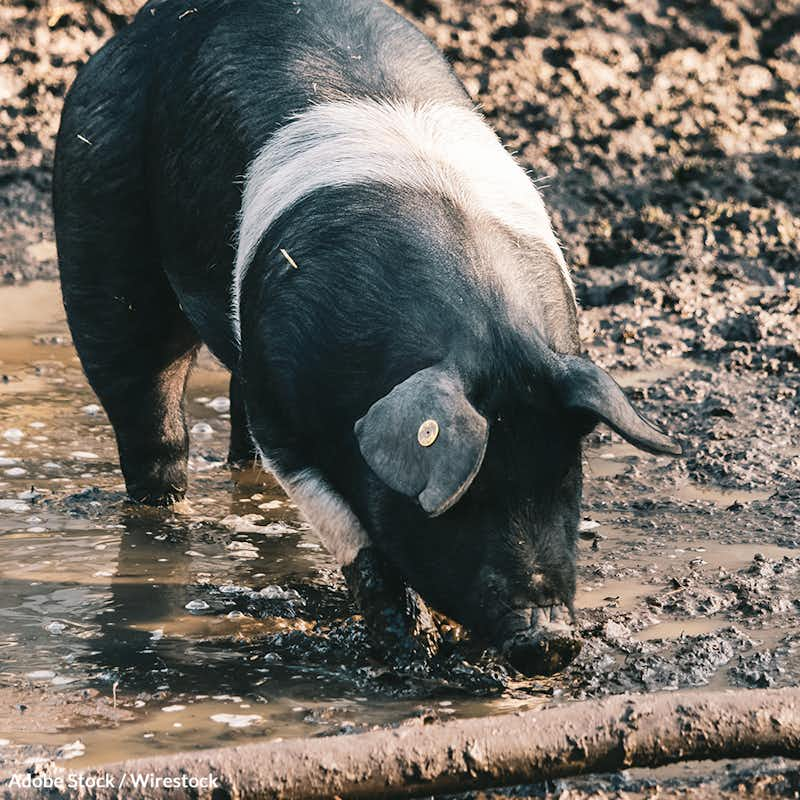Protect Our Water From Livestock Feces
11,419 signatures toward our 30,000 Goal
Sponsor: The Rainforest Site
Remind the EPA that our farms and water sources are meant to give life, not slowly take it away.

More than 2,100 large-scale hog operations in North Carolina house roughly 10 million hogs, making the coastal state one of the world's top pork producers.
A majority of the state's concentrated animal feeding operations (CAFOs) are located in Duplin and Sampson counties where hogs are said to outnumber people 40 to one1.
The state of North Carolina is one of the biggest producers of hog feces. North Carolina wet animal waste (primarily consisting of hog feces) tallies in at over 10 billion gallons2.
How does one go about managing 10 billion gallons of feces?
One of the primary ways in which hog feces has been managed in North Carolina is through anaerobic lagoons. These lagoons are created from a "manure slurry," which is washed out from underneath the animal pens and then piped into the lagoon3."
These lagoons are often constructed near primary sources of water, and operate without enclosure, meaning that gases like ammonia, hydrogen sulfide and methane are emitted into the surrounding air space4.
More than that, when coastal disasters strike North Carolina, and those primary sources of water flood, these lagoons are breached5. Gallons of feces then enter these water sources, introducing harmful substances to unsuspecting animals and people, including: antibiotics, estrogens, bacteria, pesticides, heavy metals, and protozoa.
This is detrimental to the environment and to the food webs relying upon these water sources.
Following the devastation of Hurricane Floyd, the state of North Carolina banned the construction of new anaerobic lagoons in 1999. However, this didn't include the anaerobic lagoons that were already operative6. Decades later, anaerobic lagoons remain the main method of waste management for large-scale North Carolinian hog farms7.
This is unacceptable. For our health, for the health of animals, and for the health of the environment, farmers everywhere must manage their livestock waste carefully, and with more in mind than cost.
Tell the Environmental Protection Agency that you deserve better, that our farms are supposed to give us life, not take it from us. Sign the petition below and urge the EPA to ban anaerobic lagoons entirely.
- Melba Newsome, North Carolina Health News (20 October 2021), "Unchecked growth of industrial animal farms spurs long fight for environmental justice in Eastern NC."
- Environmental Working Group (21 June 2016), "Exposing Fields of Filth in North Carolina."
- Sara Peach, National Geographic (30 October 2014), "What to Do About Pig Poop? North Carolina Fights a Rising Tide."
- Sarah Kaplan, Washington Post (10 May 2021), "Air pollution from farms leads to 17,900 U.S. deaths per year, study finds."
- Kendra Pierre-Louis, New York Times (19 September 2018), "Lagoons of Pig Waste Are Overflowing After Florence. Yes, That's as Nasty as It Sounds.."
- Talia Buford, ProPublica (23 November 2018), "A Hog Waste Agreement Lacked Teeth, and Some North Carolinians Say They're Left to Suffer."
- A.A. Szogi, Matias B. Vanotti, Journal of environmental quality (1 March 2009), "Removal of Phosphorus from Livestock Effluents."
The Petition:
To the Administrator of the Environmental Protection Agency,
In 1999, by banning the construction of new aerobic lagoons, the state of North Carolina took a big step forward in reducing the amount of livestock feces contaminating local water sources. However, it wasn't a large enough step.
Still, because the ban only halted the construction of new lagoons and not the lagoons already in operation, anaerobic lagoons continue to be a choice for large-scale farmers throughout the state. Natural disasters continue to result in the contents of these lagoons contaminating key sources of water throughout the state. Devastating substances from these farms and their livestock — antibiotics, estrogens, bacteria, pesticides, heavy metals, and protozoa — are being consumed by unsuspecting animals and people.
Even when not facing disaster, these open-topped lagoons have proven to be harmful, emitting toxic gases into the air, including ammonia, hydrogen sulfide, methane, and carbon dioxide. Not only does this affect the quality of life for those within sniffing distance, but, according to the Natural Resources Defense Council, it actually has a physical affect on the people living near these lagoons. Reported thus far are the following symptoms: headaches, shortness of breath, wheezing, excessive coughing, and diarrhea.
Administrator, our farms and water sources aren't supposed to operate this way — they're meant to give us life, not slowly take it away from us. It's unacceptable for farms to continue managing waste in this manner and I urge the Environmental Protection Agency to ban anaerobic lagoons entirely.
Sincerely,